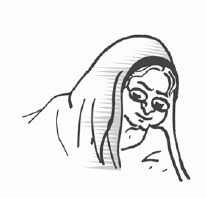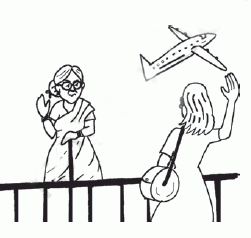Class XII Poem -1 (FLAMINGO) "My Mother at Sixty Six" - Kamla Das
My Mother at Sixty Six
About the Poet
(KAMALA DAS ‘Madhavikutty’.)

This is a touching poem written by Indian poet Kamla Das who wrote under the pen name of ‘Madhavikutty’. In this poem, she describes her feeling of love and attachment towards her ageing mother.
Once the poet went to visit her mother. She was on her way back to the airport to return to Cochin. She looked at her mother who was seated beside her in the car. Her mother had dozed off to sleep and her aging face - was smoky in color like ash. Her mouth was open and she resembled a dead body. The poet realized that her mother was old. She felt pain and sympathy for her. Her mother needed love, affection and care.
In order to come out of the gloom, the poet shifted her glance and looked out of the car’s window. There she saw young trees pass by. Little children were running out of their houses into the playgrounds. These things were contrary to the aging face of her mother. They symbolized energy, life and happiness.

As they reached the airport and the poet was about to leave for the aeroplane, she glanced at her mother one more time. Her mother appeared weak and pale just like the moon in the winter season which seems to have lost all its strength. The poet felt the pain and fear of losing her mother. She was reminded of her childhood when she used to fear losing her mother. As a child she could not bear to be separated from her mother even for a few moments. Now the loss would be permanent as her mother was about to die and she would lose her forever.
The poet did not express her feelings. She smiled and said “see you soon, Amma” because she wanted that her mother should live and they could meet again.
My Mother at Sixty-Six Explanation
My Mother at Sixty-Six:
Driving from my parent’s
home to Cochin last Friday
morning, I saw my mother,
beside me,
doze, open mouthed, her face
ashen like that
of a corpse and realized with pain
that she was as old as she
looked but soon
put that thought away, and
looked out at Young
Trees sprinting, the merry children spilling
out of their homes, but after the airport’s
security check, standing a few yards
away, I looked again at her, wan, pale
as a late winter’s moon and felt that old
familiar ache, my childhood’s fear,
but all I said was, see you soon, Amma,
all I did was smile and smile and
smile......
Explanation -
Firstly, when the poet is on her way to the cochin airport with her old mother sitting beside her, she looks at her closely and presents before us her image.
She compares her with a corpse. (similie is a figure of speech to show comparison between her mother’s face and a corpse.) As she looks at her mother’s pale and pallid face, she is struck with the horror and pain of losing her. The mother with the dozing face and open mouth is compared to a corpse. Here, the poet shows the typical love and affection which is present in a mother-daughter relation.
The poet is pained and shifts her attention outside the car in order to drive out the negative feelings. She changes her sad mood .The scene outside the window is of growing life and energy. The rapidly sprinting trees alongside the merrily playing children symbolize life, youth and vitality. The poet here is reminded of her own childhood when her mother had been young whereas now she is encircled with the fear of losing her and that has made her insecure.
She is at the airport to take a flight. It indicates departure and separation which creates melancholy. As she bids goodbye to her mother, the image of the old, wan, worn out mother in the twilight of years strikes her again. Here again a similie is used to compare her mother with a late winter’s moon whose light is obstacle by fog and mist As she looks old now, her personality is affected by it.
The poet is feeling the pain of separation, leaving her mother and going. Also, her childhood fear of losing her mother which she feels that earlier was temporary but now, could be forever as she could die of old age, is haunting her. She is so pained that it is natural for her to cry but keeping a brave front she hides her tears and smiles.
She bids farewell to her mother and keeping her hope of seeing her again alive, says “see you soon, Amma”. She hides her sorrow as she does not want to create a painful environment for her mother and conveys her that as she is enjoying her life similarly her mother should also be happy and enjoy her life.
(The poem revolves around the theme of advancing age and the fear that adheres to its loss and separation. It is a sentimental account of the mother’s approaching end through the eyes of the daughter. The seemingly short poem touches upon the theme of the filial bond between the mother and daughter smeared in the backdrop of nostalgia and fear. Nostalgia of the past (the time spent with the mother) and fear of the future without her.)
It is a short poem, without a full stop, the poem is like a long sentence, over flowing thought process. The poet uses the device of comparison and contrast, simile and repetition.
Question and answers
1. What is the kind of pain and ache that the poet feels?
ANS - When the poet looks at her mother’s face closely, she discovers that she has aged and her end is near. The feeling of her mother being old, needing care and help pains the poet as there is no one to look after her. She feels that her mother can die any moment and that then she will lose her forever. Her childhood fear of losing her mother which was then timely but now, will be forever, resurfaces. The poet feels the pain of her mother’s old age and her helplessness towards her. She has the fear of separating from her mother forever, upon her death.
2. Why are the young trees described as ‘sprinting’?
ANS -The young trees have been personified. When looked at from the poet’s moving car, they seem to be running past. The poet found it to be strikingly opposite to her mother who looked as still as a dead body.
3. Why has the poet brought in the image of the merry children ‘spilling out of their homes’?
ANS -The poet draws a comparison between what is travelling with her and what she can see outside. It’s a comparison between life and death. Her mother is sleeping, with mouth open, like a dead body, while outside she can see children who are full of life, energy and enthusiasm.
4. Why has the mother been compared to the ‘late winter’s moon’?
ANS -Just as the late winter’s moon is dull and lacks luster, so is her mother at the end stage of her life. Also, as the late winter moon gets overshadowed by the fog and mist in the sky similarly her mother can get overshadowed by death at any time. Both of them are nearing an end- one of season and the other of life.
5. What do the parting words of the poet and her smile signify?
ANS - The parting words of the poet show her positive attitude. She overcomes her pain and fear, assures herself and her mother that they would meet again. She is being very brave which is indicated by the use of repetition in the poem:
“smile and smile and smile......”
“smile and smile and smile......”
MIND MAP








Comments
Post a Comment